Hibiscus plants are well-favored houseplants among gardeners mainly because of their beautiful and vibrant flowers that add color palate inside your house and make it more lively. But have you noticed your hibiscus plant turning yellow?
If you did, don’t panic! many gardeners face a similar issue and we are here to fix that.
In this article, we will discuss the reasons why hibiscus leaves turning yellow along with the solutions and tips to gain your plant’s health back.
What does a healthy hibiscus look like?

In your garden or indoors hibiscus should bring the cheerful side. These plants are gorgeous with their numerous colorful, large, and lovely flowers.
Healthy hibiscus leaves: The upper side of the leaves are vibrant and shiny green while the lower side is more of a matt shady green. They should have smooth, undamaged edges.
Healthy hibiscus stems: The stems of a healthy hibiscus plant should be sturdy and thick. Instead of drooping they should remain upright. And definitely no yellow or brown spots.
Healthy hibiscus flowers: The flower should stay firmly against the stem and spotless base. If the flower buds feel mushy to touch, indicating that they are dead.
Causes of Hibiscus Leaves turning yellow
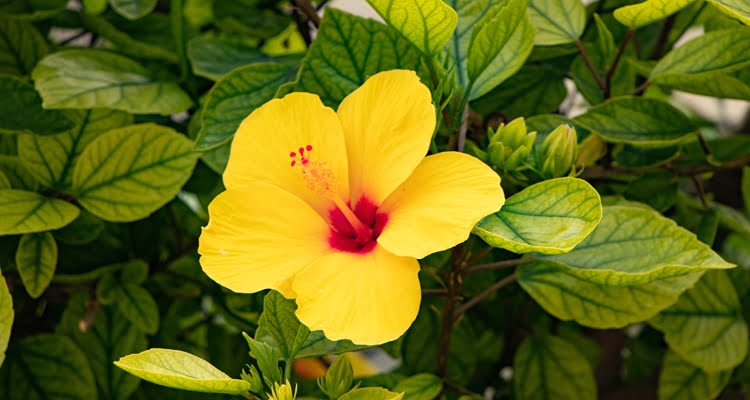
There are several factors that can lead to your hibiscus leaves turning yellow, such as:
- Nutrient Deficiencies
- Over-watering
- Underwatering
- Pests and Diseases
- Other environmental factors
Now let’s take a look at them in detail.
1. Nutrient Deficiencies

If hibiscus leaves turn yellow but not drooping or falling off the tree, pointing towards a sign of essential nutrient deficiency.
Three primary nutrients hibiscus trees are required for their growth, to maintain a lush and overall development: nitrogen, phosphorus, and potassium.
Lack of nitrogen: Nitrogen-depleted soil can result in stunted growth, faded or yellow coloration of the leaves. Nitrogen deficiency can also be identified through premature leaf shedding, leaf scorch, and underdeveloped roots.
Lack of iron: The lack of iron in the soil is responsible for the plant’s cells’ incapacity to transport oxygen all over the tree. As a result, the veins of the tree turn yellow. Clogging water in the pot also triggered this deficiency.
Lack of magnesium: The lack of magnesium levels in the plant can be caused by many factors including, using not well-ratio fertilizers, poor quality soil, hard water, and definitely insufficient use of fertilizers. High temperature also affects magnesium levels.
To spot this, examine the leaves of the lower part of the plant. The suffering leaves would display dark-green veins and yellow in between them and the edges. The plant provides all the magnesium it has to the upper part of the tree where the new growth is happening, so simply the lower part with old leaves shows the signs.
Lack of phosphorus: Along with nitrogen and potassium, phosphorus is another big name in the realm of well-balanced fertilizers. It plays a vital role in overall upper and as well as root development. Lack of phosphorus causes slow growth, reduction of seed size, and yellowing discoloration throughout the veins and areas of the leaf.
Lack of potassium: Potassium is involved in the synthesis of amino acids. Lack of potassium levels shows symptoms like weak stems, underdeveloped roots, and causing hibiscus leaves turning yellow. First, it turns yellow and then gradually expands and turns brown. Older leaves are affected by it first.
2. Over-watering
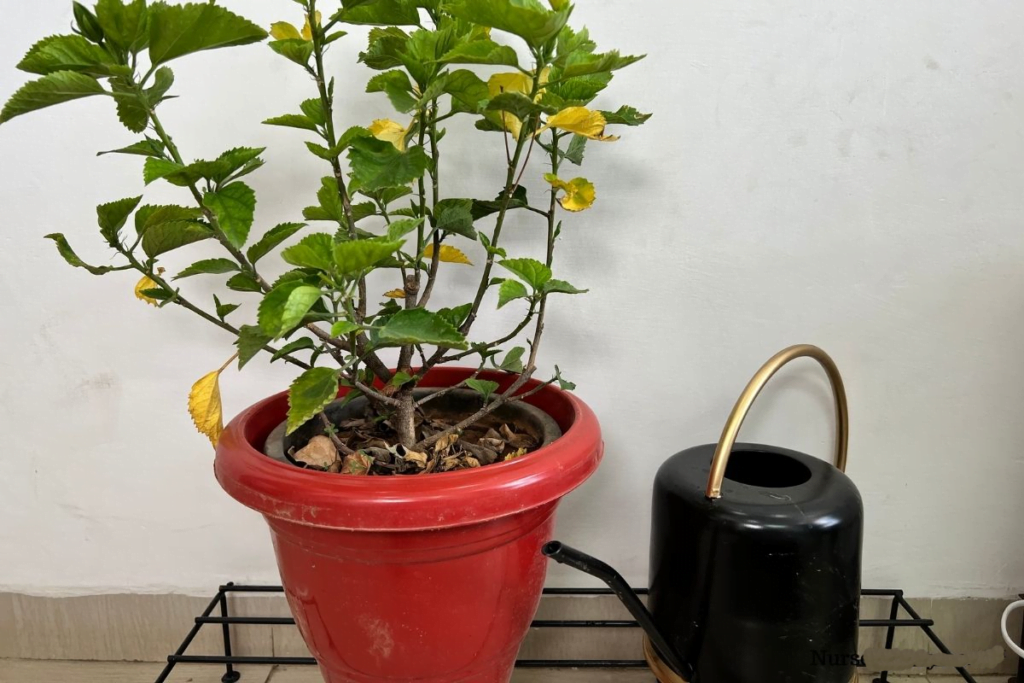
Overwatering is the most common cause of hibiscus leaves turning yellow and buds falling off. Although they prefer moist soil, they are disinclined to saturate or clogged soil.
If you overwater your plant or use poor-draining soil and pot it will have a lack of space to consume air and nutrients in the soil.
Saturated soil will lead your plant to develop root rot. Root rot can also invite various fungal pathogens and you will end up with a disintegrated root.
Use the finger method or a soil moisture meter, if the soil is muddy to the touch or reached the highest scale (way more than 4) in the meter then you are overwatering your plant.
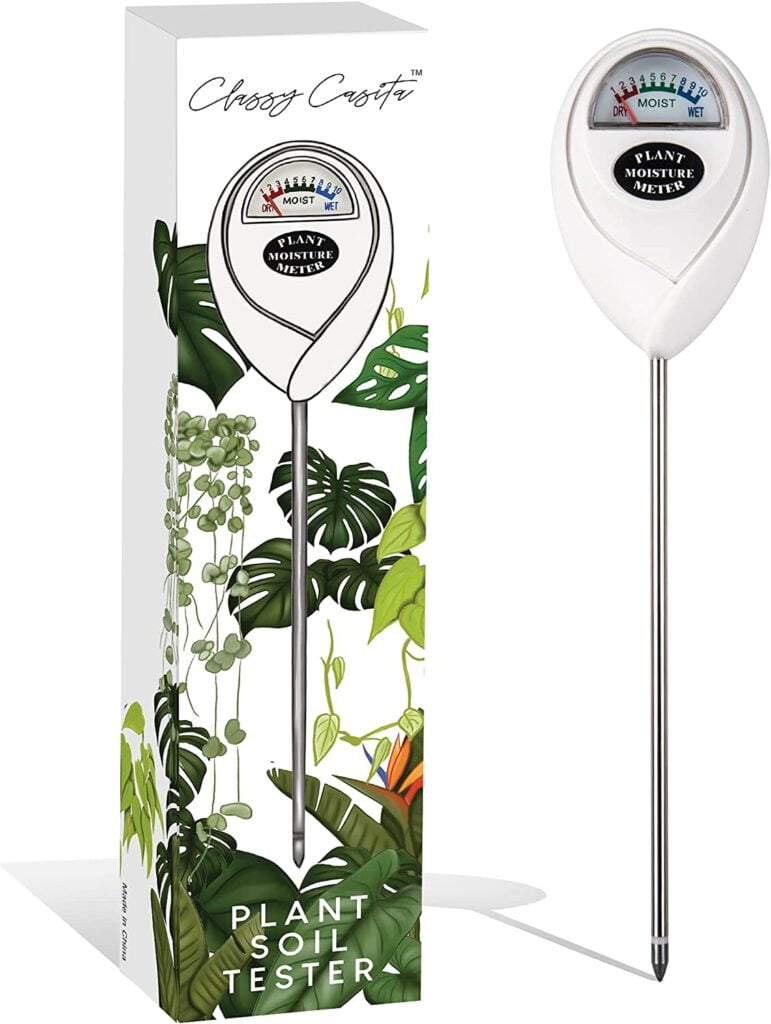
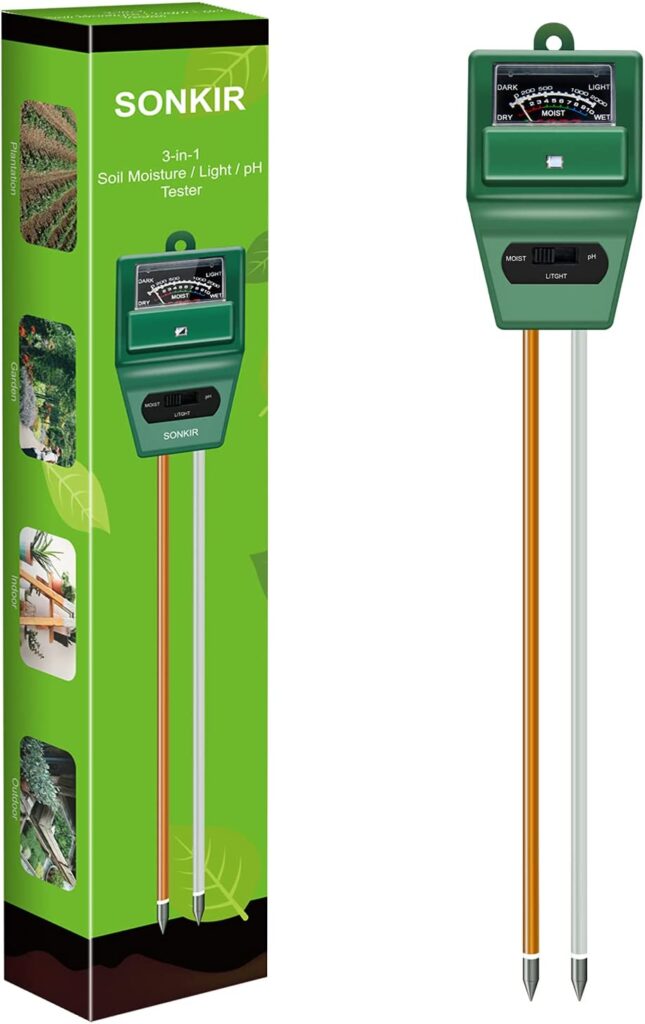

3. Under-watering
Tropical hibiscus plants require plenty of water, especially during drought seasons they get thirsty. Hibiscus that are grown in pot tends to need more water than in-ground hibiscus. Keeping the soil constantly moist is important to stop the leaves from bending, turning yellow, or falling off due to drought stress. But remember moist, not wet.
Check your soil at least every two days, if the top two inches of the soil appear bone dry way too often, it’s an indication that you are underwatering your plant.
4. Pests and Diseases
Pests
Spider mites: They are difficult to spot as they are tiny. They are red in color and have a destructive effect on hibiscus feeding on its sap. Due to the lack of nutrients in the leaves, they turn yellow. Due to the loss of fluid, the leaves will eventually curl up and die if you let them live there for a longer period.
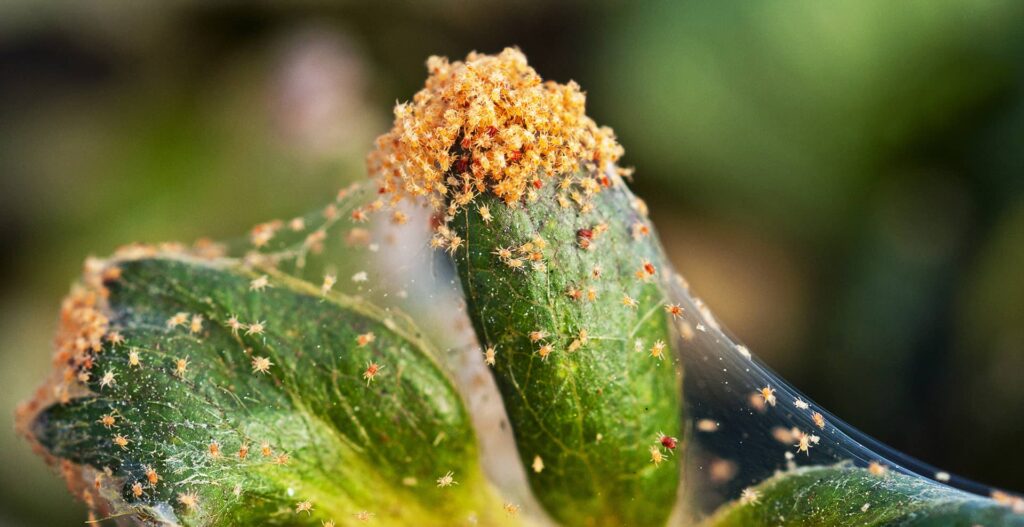
To detect spider mites look for the stripping pattern or silver pattern on the leaves. If you look closely you will locate small webs underside of the leaf with small white dots spread around it, those are the mites.
Mealybugs: Another sap-sucking insect causing severe damage by inserting their mouthparts in the leaf tissue and sucking all the nutrients, resulting in ill-growth, and yellow leaves appears as one of the first sign. They excrete honeydew and because of that, it attracts other insects in the plant.
You can detect them by locating cotton ball-like insects or by locating black sooty molds on the leaves. Honeydew accommodation makes the plant sticky and encourages other pests to create a black carpet-like layer over the leaves.
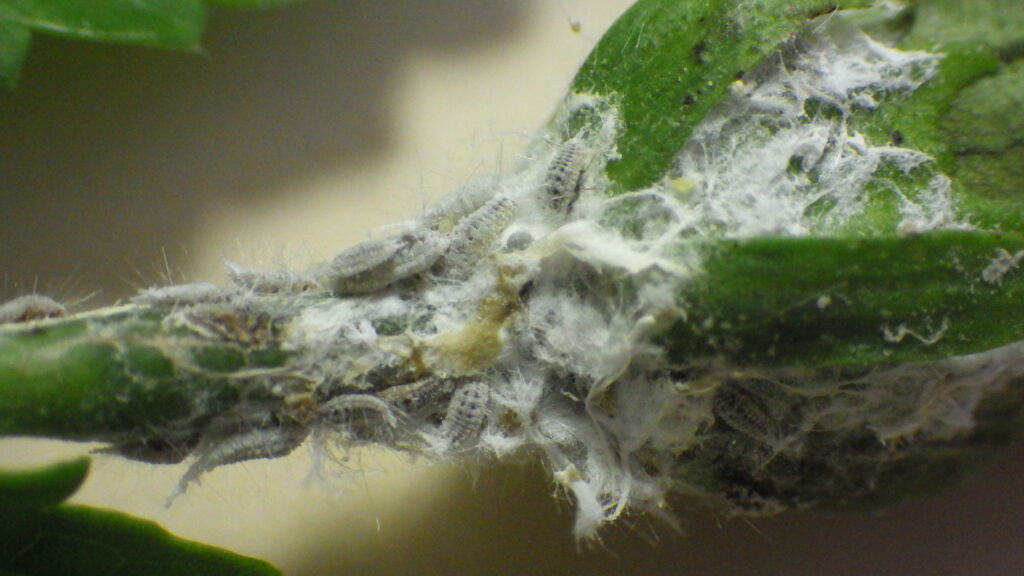
Whiteflies: Whiteflies drink the sap usually from the underside of the leaves. They cause the leaves to wilt and discolor.
As they stay underside of the leaves, they are hard to detect. You need to look out for a triangle-shaped tiny insect underside of your plant’s leaves. Their powdery wings resemble that of mealybugs.
The larvae feed on young leaves and adults feed on flowers.
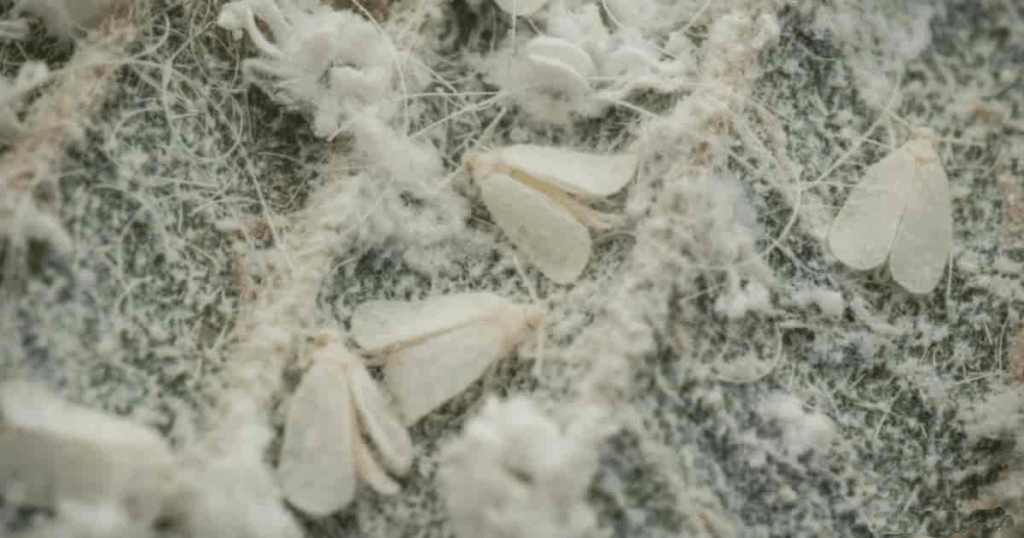
Aphids: Aphids are small insects, that suck the nutrients from the plant by injecting their piercing mouthparts. Aphids and mealybugs have similar effects on the plant, they accumulate honeydew and attract other insects, create molds on the leaves and stems, and affect plants all over health.

Diseases
It’s important to identify the disease that causes hibiscus leaves turning yellow since it can be a symptom of severe ailment:
Anthracnose: It is a fungal disease that leaves yellow spots on the leaves, with time it developed into wilt and brown leaves. They are severely contagious, just through air or contact with infected material they spread the fungus from one plant to another.
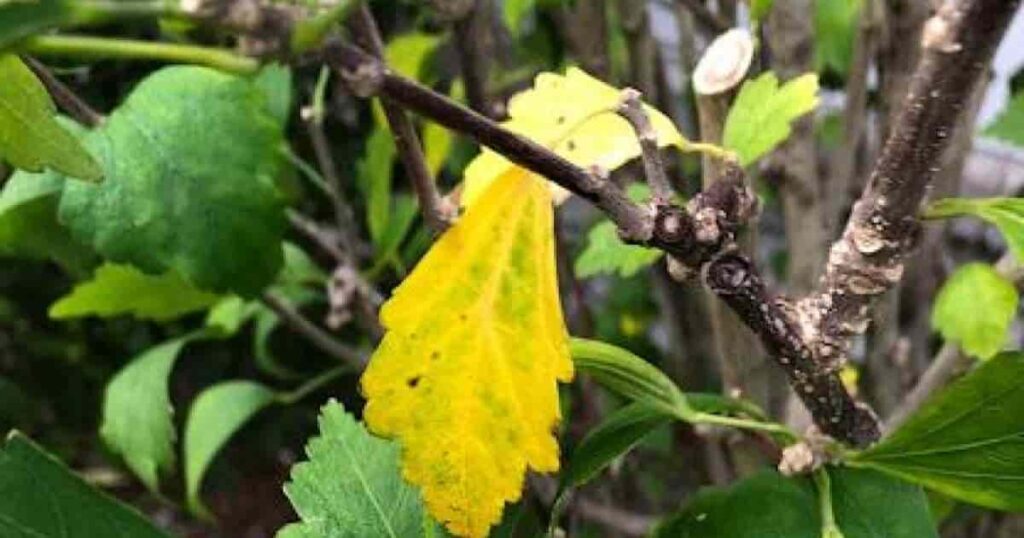
Powdery mildew: Powdery mildew common issue among various plants and hibiscus plants as well. They create a layer of white patches on the lower side of the leaf and those patches turn yellow and then brown. Plants in hot weather get more affected by it.
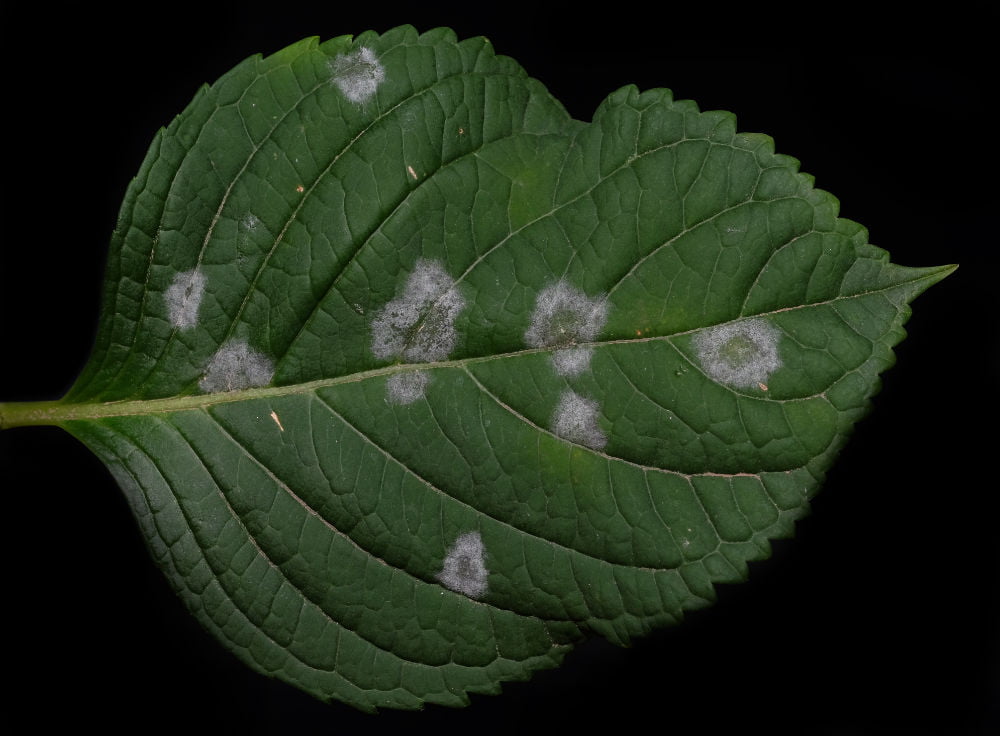
Downy mildew: They are caused by a plant pathogen called Peronospora Sparsa, but they don’t do serious harm to hibiscus. Environmental stress causes downy mildew. Affected plants would show symptoms like yellow spots on the leaves. These spots eventually turn white as they mature.
5. Environmental Factors
Various environmental stresses can be the reason for hibiscus leaves turning yellow and falling off.
High temperature and water requirements are connected. During hot summer days, hibiscus needs extra water to maintain those large, lush leaves. Without that they would be unable to cooperate with the hot weather and those leaves will get droopy, which usually turn yellow before falling off.
Hibiscus plants prefer moderate sunlight, so direct exposure to excessive sunlight will stress the plant. As a result, they will face sunburns, large white spots, and yellow spots on the leaves.
As hibiscus is native to tropical areas, it flourishes in medium to high humidity. If the humidity levels drop below 50%, hibiscus can experience various problems like yellow and wilting leaves. On the other hand, too much humidity will less airflow-prone areas dragging other issues like infection, and inability to photosynthesis.
Prevention of Yellowing Hibiscus Leaves
Proper Watering Techniques
The key to growing vibrant blooming hibiscus is to have expertise in the right watering method.
Hibiscus need lots of water for their large leaves and flowers to match their native environment, which is high in humidity and rainfall. They are not built for cold weather, so you should reduce watering during cold weather in order to avoid excessive moisture.
There are two aspects of watering to keep in mind: frequency and amount. Frequent water application is needed during warm weather and even more during hot weather. Water must be applied when the top inch of the soil dried out. And amount depends on how much you need to thoroughly moisten the soil around the root.
Hibiscus grows best in slightly acidic water with low-dissolved minerals.
Tip a few plants out of their pot just after watering it. Examine if the entire rootball is dark and wet. If you notice a visible line between the wet and dry parts, your plant needs more water. So the amount of needed water will be decided through the repetition of testing.
Proper Fertilization
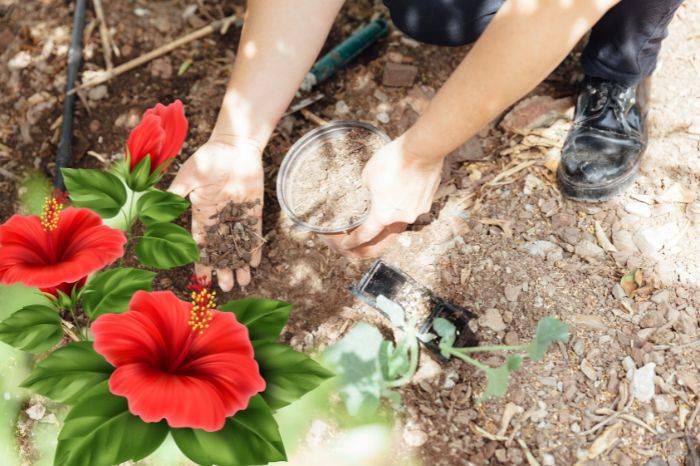
Potting mixes that are made of composted bark, coco coir, peat moss, and perlite are not enough for your plant, they lack nutrition.
They need a well-ratio of potassium, magnesium, iron, phosphorus, and nitrogen in their soil. In the US, NPK numbers on fertilizers show the percentage of Nitrogen, Phosphorus, and Potassium. For hibiscus, look for a ratio of Medium-N, Low-P, and High-K in fertilizers. Avoid fertilizers with equal NPK numbers or high levels of phosphorus, as they have too little potassium for hibiscus.
minor elements like copper, magnesium, and iron should be present in an ideal fertilizer. Chlorides in fertilizers are damaging to hibiscus plants.
It is ideal to feed them often and in small amounts. Dilute a half-dose of fertilizer every time you water and avoid using double doses even if you fertilize infrequently.
Proper Pruning Techniques

Pruning your hibiscus tree is important to get more flower buds at the end of each branch. Pruning stimulates branching, meaning more branches and more flowers. You can prune selectively and keep some blooming branches for flowering seasons or you can just get rid of those dead or sick parts to promote healthy growth.
The best time to prune depends on the location and growing conditions. Pruning during sunny, mild weather gives the best results. So just before summer when the weather is a bit on the warmer side is ideal to encourage active growth. Avoid pruning in the middle of winter or summer, cause it can put them in lots of stress.
Disinfect your pruning shears by rubbing alcohol on them, and leave the sterilizer on the blades for a bit. Plan the pruning by cutting most branches back by 1/3 or more, avoiding the top of the plant as new growths are happening there. Find a leaf node facing the direction you want the new branch to grow, and make a smooth cut above it. Check if further cutting is necessary for shaping.
Proper Soil Conditions
Use a good potting mix for your hibiscus to provide its longevity and performance. Cheap mixes can be damaging to your plant due to their heavy weight and unidentified trace mineral content.
An ideal soil should have coco coir, peat moss, or composted bark that can hold moisture and nutrients, while sand and perlite provide drainage. Adding worm castings, bat quano, or other organic material supports healthy microbial life.
If you are not certain about the soil you are positioning your plant in you can always seek guidance from a reputed nursery or garden center for a quality soil mixture with good drainage and organic components.
Treatment of Yellowing Hibiscus Leaves
Identifying the Cause for Hibiscus leaves turning yellow
As we discussed all the causes of hibiscus leaves turning yellow, we discussed how to identify them as well. Now you need to inspect your plant closely for common signs. Not just by noticing yellowing patterns but by side symptoms as well. Once you pinpoint the cause you can now move on to treat it accordingly.
Treatment Options Based on the Cause of Yellowing Hibiscus Leaves
1. Nutrient deficiencies
To treat your plant from nitrogen deficiencies, you can use organic manures like cow manure and fertilizers like ammonium sulfate and urea. But on the overdose of nitrogen will dark colored leaves and delay in blooming.
The iron that is available in the market can be affected by soil and water conditions, making it difficult for hibiscus to absorb iron from usual sources. To overcome this, you should use a form of iron that works in all conditions.
Epsom salt, that are available in the grocery store or drug store is enough to solve your hibiscus’s magnesium deficiency. They can be easily diluted in water and added to the pot to provide extra magnesium for the hibiscus. Epsom salt works well in a pot with a good drainage system.
Phosphate deficiency can easily be corrected by adding phosphoric fertilizers and keeping the correct soil pH, which should be between 5.5 and 6.8 for sufficient phosphate management.
Compost made from food byproducts is a rich source of potassium. For example, banana peels, they are rich in potassium. You can use wood ash as well, but in little amounts in order to not burn the plant. Potassium sulfate can be used if your plant is in desperate need of potassium as they are quick release and contain fifty percent potassium.
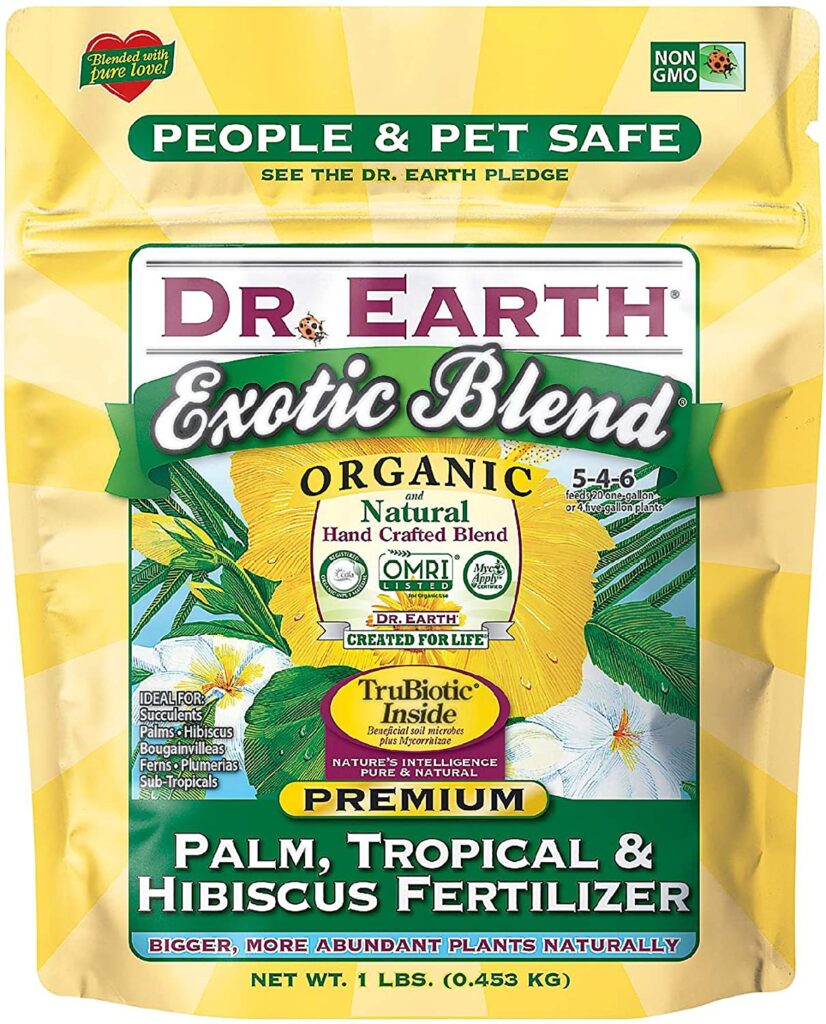
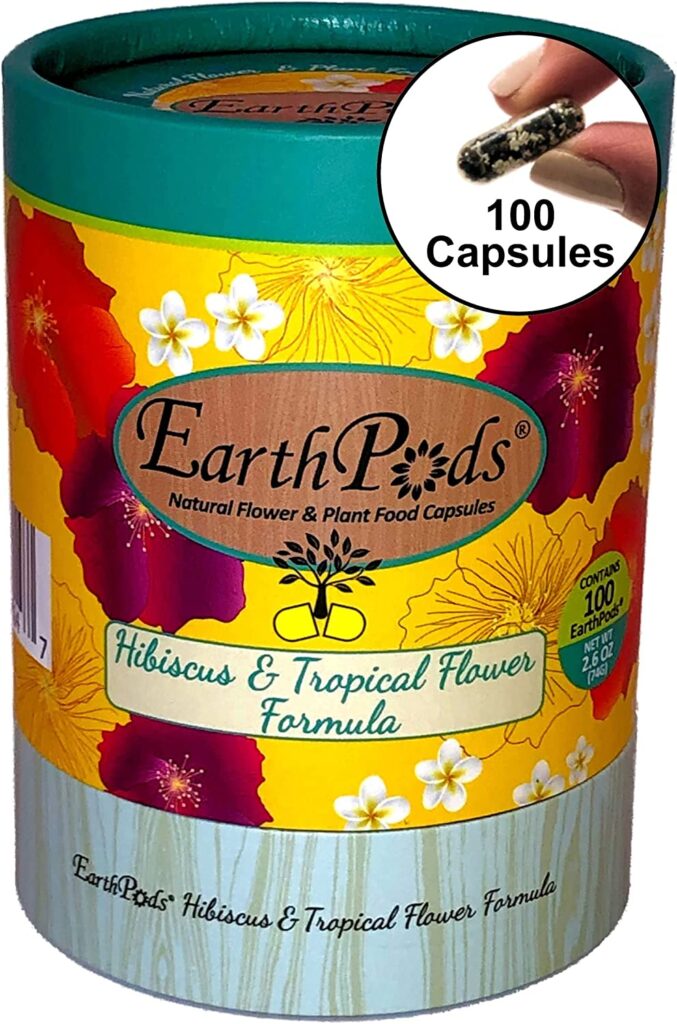

2. Over-watering
If you already over-watered your hibiscus this is how you should fix it:
Remove standing water from the drip tray and check pot drainage holes.
If roots show no rotting sign, let the soil dry naturally, but if roots are rotting you need to repot.
For badly over-watered plants, lift the plant from its pot and remove wet soil and rotting roots, then repot in fresh, moist soil.
Remove dead leaves and resume watering when the soil is barely moist, but never let it dry out completely.
3. Under-watering
Here are a few things you must do to improve your underwatered hibiscus plant:
Your dried hibiscus requires a fair dose of deep water. Water it till it’s coming out from the bottom hole.
Don’t use cold water cause it might shock the plant, instead go for room-temperature water.
If the air is too dry your plant needs a good humid environment as well. To provide that place a humidity tray filled with water and pebbles under the pot but make sure the water not touching it. Let the water evaporate and increase humidity around the plant. You can manually mist water over the plant as well.
4. Pests and diseases
Spider mites: Dilute one cup of rubbing alcohol and four cups of water and spray all over the flower, foliage and stems to get rid of spider mites. Rubbing alcohol can dehydrate them and eventually kill them.
Mealybugs: Best homemade treatment would be using dish soap. Mix one tablespoon of dish soap in a cup of water and your mealybug killer is ready to use. Do a patch test in one leaf before proceeding with the whole plant.
Whiteflies: First prune the infected leaves with a clipper and dispose of them carefully. Once done, use a hose and blast with water weekly to scatter the pests. After that use horticultural oil, soapy water, or neem oil to suffocate them.
Aphids: You can use soapy water or oils, but if the damage is severe you can go for Pyrethrum spray. Pyrethrum also kills beneficial insects so be careful with its use. Mix concentrated pyrethrum in rubbing alcohol and use it.
Anthracnose: Apply liquid copper sprays and sulfur powders weekly, during early spring, and throughout the whole growing season. Apply during the morning and avoid spraying in hot weather.
Powdery Mildew: Use lime-sulfur, sulfur, neem oil, potassium bicarbonate, or baking soda as organic fungicides for powdery mildew. Apply before infection or at the first signs of infection for best outcomes.
Downy Mildew: You can use the same treatments as for powdery mildew.
5. Environmental factors
Move your environmentally stressed plant from direct sunlight and place them in bright shade to help them recover and revive. Give them time to recuperate from the stress.
Daily misting with a spray bottle will help them to recover from plants that are stressed from humidity. Cover the whole plant by misting it to provide extra moisture.
If the stress is severe use a growth enhancer, they are designed with growth hormones and they provide extra minerals to help your plant come out from the stress as quickly as possible.
Keep treating your plant till you notice the emerging greenery in them and new green leaves.
Other reasons for yellowing hibiscus leaves:
The reasons I have described before are the primary reasons for hibiscus leaves turning yellow. If those factors do not match your plant’s current situation, here are some other reasons that can be responsible for yellowing hibiscus leaves.
1) Over fertilization:
Lack of nutrition is one of the primary causes of yellow leaves on hibiscus but that doesn’t mean you can overfeed them and they will turn greener than normal. The irony is that it will also turn the leaves yellow. Overcrowded soil with fertilizer will make the roots hard to absorb and also improper fertilizer may change the soil pH as well.
Other than yellowing of the leaves you will also notice drying out leaves and they are falling off prematurely. If your hibiscus is getting too much nitrogen (the most common ingredient in every fertilizer) you will notice an abundance of growth with zero fruit or flower production.
Solution:
If only a few leaves turned yellow, you can rinse the soil by watering it, water till it’s running out of the bottom of the holes of the pot. After that put the pot where air circulation is good and have moderate sunlight reach to make sure it doesn’t face any issues related to overwatering.
If the yellowing spreads too much and seems out of your control, you need to repot it with a fresh set of soil. The leaves that have already turned yellow won’t turn back to green again, but the new growths will be fresh and healthy.
If your hibiscus is growing in the ground or if you are using soil from your garden, I suggest you test the soil contents first. It will give you a head start on what your plant needs.
2) Cold stress:
Fluctuations in temperature–hot or cold–impact the health and color of the leaves of the hibiscus. Hibiscus are also sensitive to cold drafts. When prolonged chilly temperatures or late spring cold drafts happen, your hibiscus leaves may lose their color. Keep an eye on nighttime temperatures as well. When a late frost is predicted, wrap your plant or give some kind of protection for the night.
You will notice yellowing hibiscus leaves, and in some cases, the edges will turn brown or appear burned.
Solution:
Patience and time will fix most cases. Fine sunny days will bring your plants back to their previous glory and chlorophyll will return to the leaves. In case of cold, use something to cover your plants in the evening.
3) Ageing:
As many plants age, the lower leaves of your hibiscus tree will turn yellow and fall off. This is just a typical phase of their growth.
In this matter, don’t worry. If the plant becomes too leggy, you can trim it back to the central stem to encourage new growth and bushiness.
4) Stress from repotting:
Repotting a plant is necessary, but it can also leave it under stress. When your tree tries to fit into its new home it will show signs of struggle by turning its leaves yellow. It can also happen to the healthiest trees.
Solution:
The most reasonable thing you can do in this matter is to provide your plant enough time for its roots to settle in and see its source of nutrients in the fresh soil. During this time, don’t give extra nutrition to your plant.
Conclusion
In conclusion, causes arise with a variety of factors, from environmental stress to pesticides to negligence. But we expect that now you are capable of identifying the cause and taking proper action and fix the issue. Best of luck!
FAQs
Q1. What is the main cause of hibiscus leaves turning yellow?
Ans. For indoor hibiscus plants, it’s insufficient light. If the plant not receiving enough light, its leaves may turn yellow. As tropical plants, they require partial shade to full shade to develop. But the full sun doesn’t mean you should place it in too much direct sunlight in drought seasons, if you do it will give your plant sunburns, and white and yellow spots just like humans.
Q2. How often should I water my hibiscus plant?
Ans. Container hibiscus needs daily watering, while hibiscus planted in your garden requires watering evening every alternative day. Gently inject your finger into the soil, if it’s saturated to the touch you are definitely overwatering your plant. Refrain from watering for a while, when the top inch of soil is completely dry provide water again. But remember, never let the soil dry out completely.
Q3. Can I use any type of fertilizer on my hibiscus plant?
To best fertilize hibiscus plants, it is recommended to use slow-release or water-soluble fertilizers. As for all-purpose fertilizer, you can go for “Burpee Natural All Purpose Granular Organic Food”, their adaptable formula is a great choice for all-purpose gardening use and definitely for your hibiscus tree.
Q4. How can I prevent pests and diseases from affecting my hibiscus plant?
Ans. Regular inspection, and using neem oil, given proper circumstances, is a healthy habit to keep pests and fungus-causing diseases away from your plant. Never ever overcrowd them, as over-humid conditions and poor air circulation invites pests and promote fungus. Make sure your plants are receiving good airflow.
Q5. Is it normal that my hibiscus leaves turning yellow in the fall?
Ans. Hibiscus plants growing seasons are spring, summer, and fall. As autumn comes to an end, the plant may shed some leaves, with others turning yellow. Hibiscus leaves turning yellow and falling off of the leaves is a sign that the plant is entering dormancy.
Related Articles
- 10+ Money plant Benefits That Will Make you Keep It In Your House
- Arrowhead Plant Care- An Ultimate Guide to To Take Care of Your Arrowhead Plant.
- Birds Of Paradise Leaves Curling- 7 Alarming Reasons And How To Fix Them?
- Are Spider Plants Toxic to Cats?- 4 Ways To Prevent Your Cats From Eating Spider Plants.
- How to Treat Fungal Infection in Bonsai Trees at Home
- How to Grow & Care for Variegated Snake Plant



